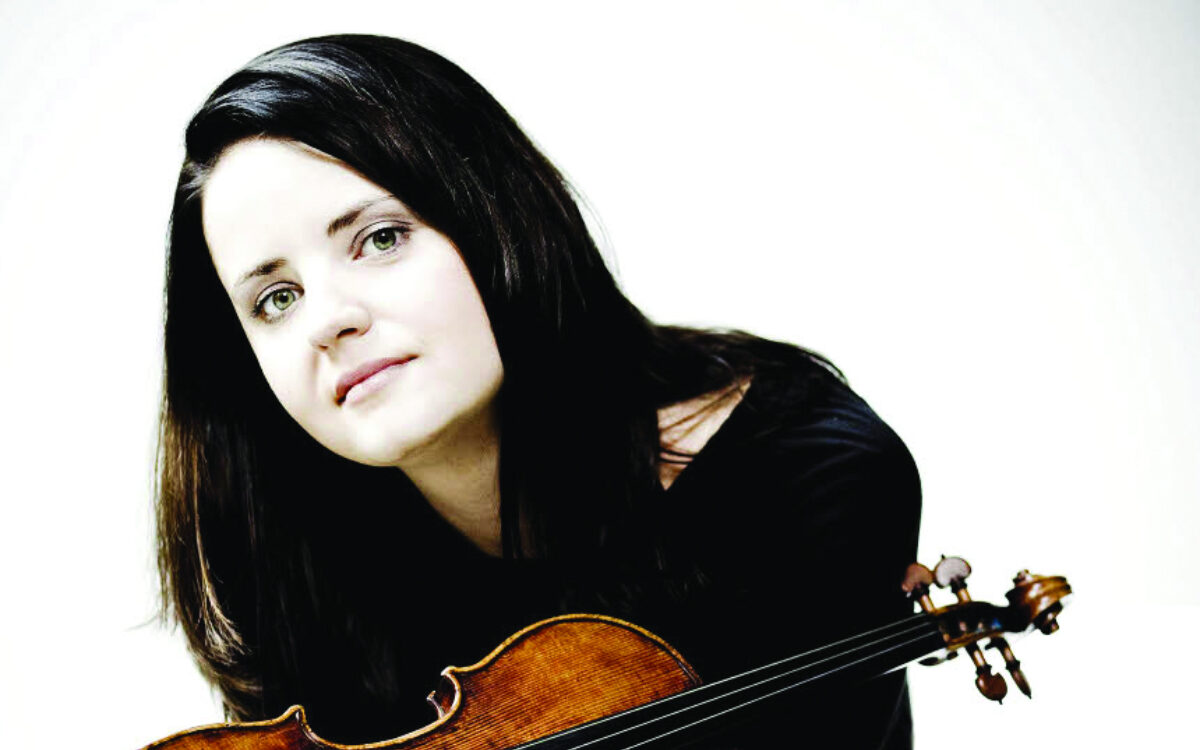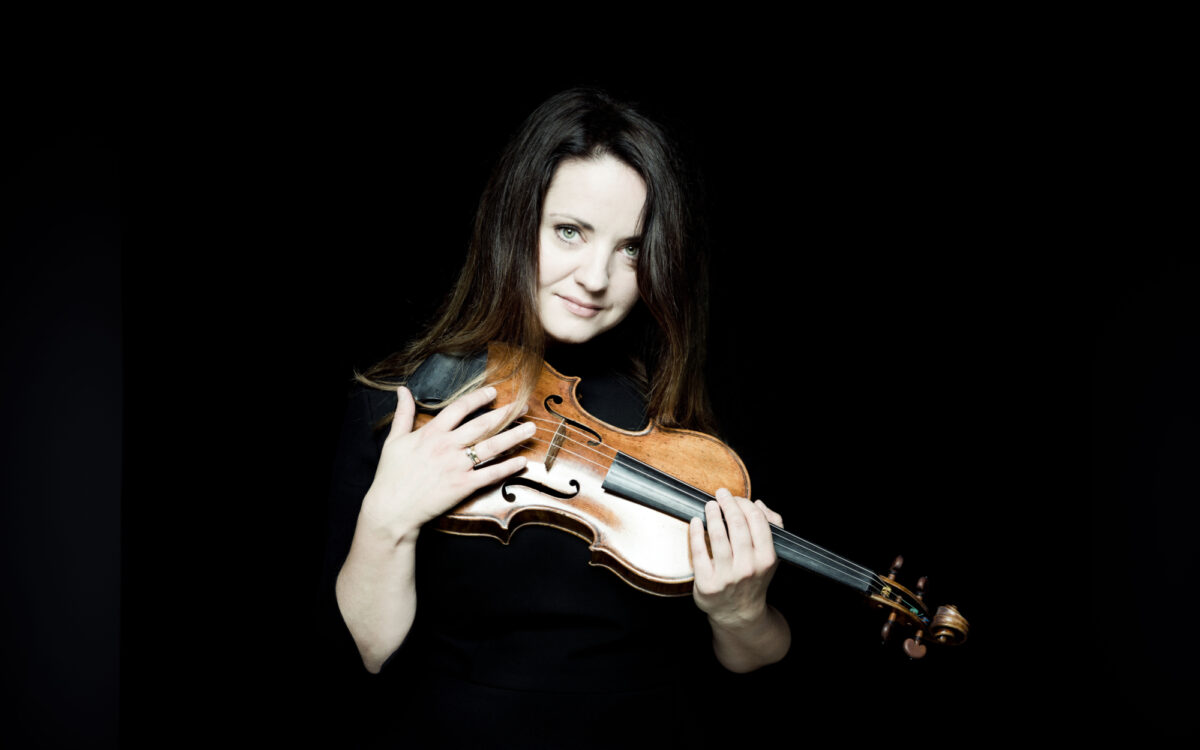Violin Concerto No. 1, Opus 77[99]
Dmitri Dmitriyevich Shostakovich was born in St. Petersburg on September 25, 1906, and died in Moscow on August 9, 1975. He composed his Violin Concerto No. 1—giving it the opus number 77—in 1947-48, but political difficulties deferred the premiere. It was another seven years until the work was first performed, on October 29 and 30, 1955, with the Leningrad (formerly St. Petersburg) Philharmonic under the direction of Yevgeny Mravinsky, and David Oistrakh, the work’s dedicatee, as soloist—at which time Shostakovich recatalogued it as his Opus 99. Oistrakh, during his first visit to the United States, gave the American premiere on December 29, 1955, with the New York Philharmonic under Dimitri Mitropoulos.
In addition to the solo violin, the score of Shostakovich’s Violin Concerto No. 1 calls for 2 flutes and piccolo (doubling 3rd flute), 2 oboes and English horn (doubling 3rd oboe), 2 clarinets and bass clarinet (doubling 3rd clarinet), 2 bassoons and contrabassoon (doubling 3rd bassoon), 4 horns, tuba, timpani, tam-tam, tambourine, xylophone, celesta, 2 harps, and strings (first and second violins, violas, cellos, and double basses). The concerto is about 37 minutes long.
When he set to work on his brooding and brilliantly virtuosic First Violin Concerto in the summer of 1947 at his dacha on the Gulf of Finland, Shostakovich had a specific soloist in mind: David Oistrakh (1908-1974). Nearly the same age, the two men had known each other for many years. In 1935, they had toured Turkey together as part of an official Soviet musical delegation; Oistrakh described Shostakovich as “an excellent travel companion.” Just a few months before he began working on the Concerto, Shostakovich and Oistrakh had performed his Second Piano Trio in Prague, with Czech cellist Miloš Sádlo. By this time, Oistrakh, raised in a Jewish family in Ukraine, was an internationally celebrated violinist and a highly valued musical asset for the Soviet regime, which rewarded him with a comfortable apartment in the same prestigious Moscow building for creative artists where his longtime friend Sergei Prokofiev lived, along with the freedom (extremely rare in Stalin’s Russia) to travel abroad.
According to Oistrakh’s son Igor, his father “adored Shostakovich as a genius, and followed his development since the time when the unique individuality of the 19-year-old composer of the First Symphony first rose as a bright star in the heavens of music.... The main links between them were similar traits of character—a complete abandonment in art, artistic ‘maximalism,’ an organic and uncompromising attitude, and their extremely developed sense of duty.” Shostakovich also dedicated his Second Violin Concerto (1967) to Oistrakh. Their friendship lasted until Oistrakh’s death in October 1974, less than a year before Shostakovich’s passing.
As usual, Shostakovich worked quickly on the First Concerto, and had completed two of the four movements by the end of 1947. While he was composing the Finale, however, the world of Soviet music was rocked by the appearance of a Decree from the Communist Party Central Committee published in newspapers on February 10, 1948. “On the Opera The Great Friendship” attacked the composer Vano Muradeli for “formalist tendencies” and launched a brutal ideological (and personal) assault on leading Soviet composers, including Prokofiev and Shostakovich. Coerced by Stalin’s cultural commissar Andrei Zhdanov, the Union of Soviet Composers convened a congress, at which Zhdanov charged that Shostakovich’s music reminded him of “a musical gas-chamber.” Shostakovich and others were forced to admit to their “mistakes” and to promise in the future to write for “the people” and to obey Party directives. So distraught and guilt-ridden was Shostakovich over what he considered his cowardly behavior at the Composers’ Congress that he allegedly considered suicide.
According to his close friend Isaak Glikman, Shostakovich would return home from the “shameful, vile discussions at the Congress” to work on the Violin Concerto’s third movement. “I finished it, and I think it came out pretty well,” he said modestly. For Glikman, this solemn and hymn-like F-minor Passacaglia, the longest of the four movements, in a form popular in Baroque music that sets variations over a repeating bass line, “conveyed the composer’s feelings and spirituality, erasing the line between the internal and external world.” (Shostakovich had previously used the form of the Passacaglia to stunning dramatic effect in his opera Lady Macbeth of Mtsensk, banned on Stalin’s orders in 1936.)
The consequences of the 1948 campaign against Shostakovich were far-reaching; most of his works were banned from public performance, and he lost his prestigious teaching positions at Moscow and Leningrad Conservatories. For the next few years, until Stalin’s death in 1953, he supported himself and his family by writing patriotic cantatas like The Sun Shines Over Our Motherland, and scores for politically orthodox films, including The Fall of Berlin, a propagandistic encomium to a god-like Stalin. At the same time, however, he continued to write more “private” music: the String Quartets nos. 4 and 5 and the 24 Preludes and Fugues. He also composed music “for the desk drawer,” which he knew would have no chance of being performed in public, such as From Jewish Folk Poetry (1948), settings of Jewish folk texts for three singers and piano that waited until 1955 for its premiere.
It was in part its pronounced Jewish flavor—especially the furious 2/4 Klezmer-style dance theme in the Scherzo for clarinet and strings—that also led Shostakovich to withhold the newly completed First Violin Concerto from performance. In 1948, a new wave of antisemitism was building in the USSR, leading to arrests and executions of prominent Jewish cultural figures. Although he was himself not Jewish, Shostakovich’s longtime fondness for and interest in Jewish culture and music was well known among his friends—many of them Jewish, including Oistrakh. “The distinguishing feature of Jewish music is the ability to build a jolly melody on sad intonations,” Shostakovich is reported to have said. “Why does a man strike up a jolly song? Because he feels sad at heart.” In 1943, Shostakovich had completed an opera by his student Veniamin Fleishman about Jewish village life in Tsarist Russia, Rothschild’s Violin; the work was left unfinished when Fleishman was killed in World War II. Shostakovich would incorporate Jewish themes into numerous major works: the Second Piano Trio (1944), the First Violin Concerto, From Jewish Folk Poetry, the Fourth String Quartet (1949), and the Babi yar Symphony No. 13 (1962).
Apart from its “Jewishness,” the First Violin Concerto, in dark A-minor, possesses other features officially unacceptable in the strictly controlled cultural environment of late Stalinist Socialist Realism. Its form was challenging and unusual, dominated by two long slow movements—an opening Nocturne and a Passacaglia—and a knotty cadenza between the last two movements. The highly dissonant melodic and harmonic language lacked good “tunes”; the overall mood was melancholy, philosophical, even tragic. Nor was the grotesque and satirical character of the two fast movements likely to please the censors, who viewed satire as a dangerous tool of sedition.
At the time, Soviet composers were being encouraged—forced—to write “accessible” and “happy” music in a straightforward tonal style, preferably in major keys, best in C major. The Concerto’s final movement, a circus-style Burlesque, unfolds frantically rather than optimistically, with a return at the end to the suspicious Jewish theme of the second movement. It also remains in A-minor rather than moving towards the major chord expected of dutiful Soviet composers (and supplied by Shostakovich himself, for example, in the Fifth Symphony).
The Concerto is also the first large-scale work of Shostakovich to contain his personal musical “signature”: the notes D-E flat-C-B (in German notation, D-S-C-H). This motto appears, transposed and slightly altered, in the second movement (not coincidentally, alongside the “Jewish” material), and in both of the following movements (and the cadenza). In the years to come, Shostakovich would insert this motif into many of his most intense and personal works, including the Tenth Symphony and the Eighth String Quartet. It affirmed the enduring strength of his creative individuality and personality amidst the oppressively communal atmosphere of Soviet Communism.
The Concerto’s long-delayed premiere was a major event in the history of Soviet music. Oistrakh already knew the piece, which Shostakovich had played for him on the piano in his Moscow apartment in 1948. (In an interview with Elizabeth Wilson, cellist Mstislav Rostropovich accused Oistrakh of intentionally delaying the premiere because he feared the wrath of Soviet authorities, but it was not just Oistrakh’s decision, since a conductor and orchestra also had to agree.) The concerto makes extraordinary technical demands (double and triple and quadruple stops, harmonics, extensive playing high on the G string, rapid-fire scale passages) on the soloist, rarely silent throughout. The original version provides no break after the exhausting cadenza, which proved too much even for Oistrakh. He asked Shostakovich to give him a rest for the first eight bars of the finale, so “at least I can wipe the sweat off my brow.” Shostakovich agreed, giving the first statement of the theme to the orchestra, although he also preserved the original version as an alternative.
Only two months after the hugely successful Leningrad premiere, Oistrakh played the concerto at a historic concert at Carnegie Hall, on December 29, 1955, with Dmitri Mitropoulos and the New York Philharmonic. One of the opening events in the new era of post-Stalinist Soviet-American cultural exchange, it was a musical and political sensation, and even broadcast on radio. Oistrakh then took the concerto on tour around the United States, where it solidified Shostakovich’s position as a major figure not only in Soviet, but world music.
Harlow Robinson
Harlow Robinson is an author, lecturer and Matthews Distinguished University Professor of History, Emeritus, at Northeastern University. His books include Sergei Prokofiev: A Biography, The Last Impresario: The Life, Times and Legacy of Sol Hurok, and Russians in Hollywood, Hollywood’s Russians. He has contributed essays and reviews to The Boston Globe, The New York Times, Los Angeles Times, Symphony, Musical America, and Opera News, and program essays to the Boston Symphony Orchestra, Los Angeles Philharmonic, New York Philharmonic, Aspen Music Festival, and Metropolitan Opera.
The first American performance of Shostakovich’s Violin Concerto No. 1 was given by its dedicatee, David Oistrakh, on December 29, 1955, with Dimitri Mitropoulos and the New York Philharmonic.
The first Boston Symphony Orchestra performances of Shostakovich’s Violin Concerto No. 1 were led by Erich Leinsdorf in November 1964 with soloist Leonid Kogan, followed by a Carnegie Hall performance that December.


